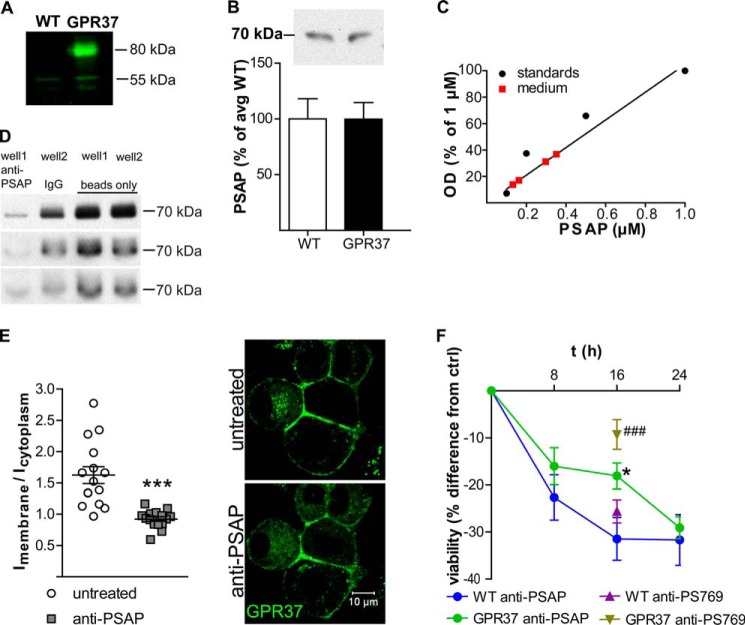FIGURE 3.
WT and GPR37tGFP-expressing N2a cells both express low levels of endogenous GPR37 and secrete PSAP but respond differently to inhibition of extracellular PSAP. A, Western blot for GPR37 on lysates from WT and GPR37tGFP-expressing cells showing a weak band at the size corresponding to untagged GPR37 in both cell types and an additional band at the size corresponding to GPR37tGFP in the GPR37tGFP-expressing cells. B, Western blot for extracellular PSAP using medium from WT and GPR37tGFP cells shows that both cell types secrete equal amounts of PSAP (n = 9, p = 0.99). C, estimate of PSAP concentrations in the conditioned medium of differentiated GPR37tGFP cells based on Western blot analysis. The calibration curve was generated using a standard series of PSAP solutions that were analyzed on the same gel as the conditioned medium. D, immunoprecipitation of PSAP from conditioned cell medium using anti-PSAP (well 1) or normal rabbit IgG (well 2) as a negative isotype control. 40 μg ml−1 anti-PSAP precipitates 83–96% of all PSAP compared with beads alone. Western blot films show three separate immunoprecipitation experiments. E, quantification of GPR37 density at the plasma membrane versus cytoplasm before and after inhibition of extracellular PSAP using anti-PSAP (n = 15 visual fields). Representative images of live cells show distribution of GPR37 with or without anti-PSAP. Data from Western blots and GPR37 density were analyzed by Student's t test. Data from MTT assays were analyzed by two-way analysis of variance followed by t test for pairwise comparisons, ***, p < 0.001 compared with WT. F, MTT assay of WT and GPR37-overexpressing cells untreated or treated with the PSAP-specific antibodies anti-PSAP (antibody: F(2,138) = 3.6, p < 0.05; cell type: F(1,138) = 5.0, p < 0.05; interaction: F(2,138) = 0.9, p = 0.41) or anti-PS769 (antibody: F(1,60) = 42.4, p < 0.001; cell type: F(1,60) = 9.2, p < 0.01; interaction: F(1,60) = 9.6, p < 0.01) (n = 24 in each group). ###, p < 0.001 compared with WT anti-PS769; *, p < 0.05 compared with WT anti-PSAP.

